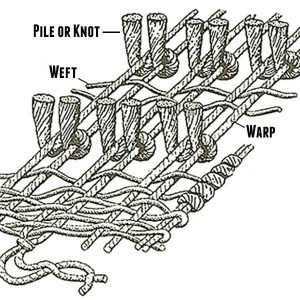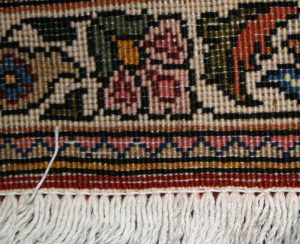In today’s market there are many types of handmade rugs including kilms, sumaks, tapestries, etc. However the rugs most often chosen for a luxurious look and long term use are handwoven knotted pile carpets produced in Iran, India, Pakistan, China, Afghanistan, Turkey, Russia, Rumania, Armenia, and Nepal. A pile rug, which may take months or even years to complete, differs from other hand-made floor coverings in that the knots are individually inserted into the foundation and then cut one at a time.
The quality of an oriental rug not only depends on knot count and materials used, but on many other factors such as complexity of design, number of colors, and dying techniques.
The first things to ask yourself are:
Do the colors and size meet your needs?
Does the carpet look beautiful and fit within your budget?
After locating a few pleasing rugs:
- The structure of the carpet, consisting of the knotted pile, warp and weft threads, fringe and selvedges, should be closely examined.
The knot count may vary from 50 to 1,000 knots per square inch. A higher count usually indicates a more valuable rug, but not always. The degree of fineness of the rug can be determined by looking at the back.

The pile should be checked closely for holes, stains, and moth damage (especially in older rugs).
The fringe should be inspected to determine if it is in good shape, is original or the sides of the rug should be strong and fairly straight.
2. The colors should be examined for running. By wiping a damp cloth firmly over the rug, you can determine if the colors will run. Sometimes in new carpets, you will see faded or antique looking effects. These are simply fashionable dying effects to create an antique look.

4. The lay of the rug is important. Often minor imperfections and wrinkles can be easily fixed by stretching or blocking.
It’s standard with most dealers to let you try out different carpets on a “free trial” basis. This will give you the opportunity to find out if your selection fits with your decor.
Finally, there are so many factors that determine the quality and value of an oriental rug that it takes caution and thorough study to make an intelligent purchase. Give Buddy a call if you have any questions! Once you’ve purchased your oriental you will want to make sure it is properly cleaned and cared for regularly. Buddys Carpet Care cleans everything from the finest to the most basic rugs from around the world. We will pick your rug up and bring it to our special cleaning plant where it will receive a very thorough Nine Step Cleaning System to get maximum soil and spot removal.
To learn more about our nine stop oriental rug cleaning process click here!

